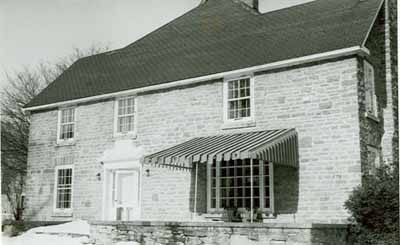Homewood National Historic Site of Canada
Maitland, Ontario

General view
© Parks Canada Agency/ Agence Parcs Canada
Address :
north side of Highway 2, Maitland, Ontario
Recognition Statute:
Historic Sites and Monuments Act (R.S.C., 1985, c. H-4)
Designation Date:
1982-11-19
Dates:
-
1800 to 1801
(Construction)
-
1830 to 1830
(Addition)
-
1945 to 1945
(Other addition)
Event, Person, Organization:
-
Dr. Soloman Jones
(Person)
-
Louis Brillière
(Builder)
Other Name(s):
-
Homewood
(Designation Name)
Plaque(s)
Existing plaque: north side of Highway 2, Maitland, Ontario
Construction of Homewood was begun in 1800 by Dr. Solomon Jones, a prominent Loyalist, local officeholder and early resident of this region. With its balanced fivebay façade, centre hallway plan and classical detailing, it reflects the influence of British Palladianism, while its fieldstone construction and steeply pitched roof echo the Quebec traditions of its builder, the Montréal mason, Louis Brillière. In spite of several additions, Homewood retains much of its original character and vividly refelcts the way of life of a rural professional man in the early 19ty century.
Description of Historic Place
Homewood National Historic Site of Canada is a very early 19th-century two-storey stone residence set just back from the St. Lawrence River a few kilometres east of the hamlet of Maitland in eastern Ontario. Official recognition refers to the house and its property at its time of designation in 1982.
Heritage Value
Homewood was designated a national historic site of Canada in 1982 because: with its balanced five-bay façade, centre hallway plan and classical detailing, it reflects the influence of British Palladianism, while its fieldstone construction and steeply pitched roof echo the Quebec traditions of its builder, the Montreal mason Louis Brillière; Homewood vividly reflects the way of life of a rural professional man in the early 19th century.
Homewood was built in 1800-1801 as the residence for Dr. Solomon Jones (1756-1822), a prominent south-eastern Ontario Loyalist. It was constructed of stone by Montreal mason Louis Brillière, and today retains much of its original character. The building has had two major additions - a rear addition constructed about 1830, and a west wing in 1945. The house remained in the Jones family until the 1960s when it was purchased by the Dupont company. In 1974 it was acquired by the Ontario Heritage Foundation for preservation as a museum.
Sources: Historic Sites and Monuments Board of Canada, Minutes, November 1982 and November 1987.
Character-Defining Elements
Key features contributing to the heritage value of this site include: the siting, back from the river and the historic east-west highway; its proximity to Lake Ontario on a major early water transportation route; the pastoral quality of the immediate setting; the rectangular (14.63m x 11.58m) massing of the original house under its steep, front-sloping pitched roof; the simplified Palladian features including the symmetrically organized five-bay façade, with evenly-spaced 12 over 12 sash windows, central entry with side and top lights and a Palladian window above; the surviving early furnishings and fittings, in particular, the original hardware, hall furnishings, and original mantelpieces; the integrity of the centre-hall plan with kitchen wing; the sympathetic design of the 20th-century addition; archaeological evidence of former outbuildings and landscape features.